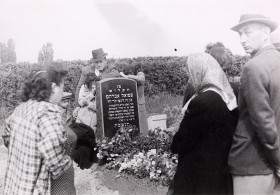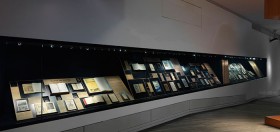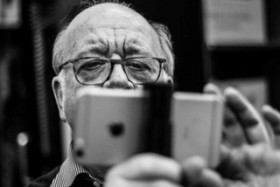The Tragic Fate of Shmuel Dancyger Z. L.

The family at the grave of Shmuel Dancyger; Jewish Museum Berlin, gift of Morris Dancyger
During a visit to my hometown of Calgary Alberta, Canada in the summer of 2014, I had the opportunity to meet with Morris and Ann Dancyger, both child survivors of the Holocaust. Morris Dancyger was one of the very few children to have been liberated by the Russians at Auschwitz on 27 January 1945. In the iconic footage of the children displaying their tattooed arms, four year old Morris is in the center of the picture. Ann Dancyger and her mother had miraculously survived an execution in 1942 near the town of Ratno where she was born, and spent nearly three years thereafter in hiding. After a nearly two year trek to Germany following the end of the war, she was able to come to Calgary where relatives lived. I had not known the Dancygers while growing up in the city, and although I had much later read about the tragic fate of Morris Dancyger’s father Shmuel, I was completely unaware that his wife and children had settled in Calgary. → continue reading
A Guest Entry by Rudij Bergmann
Accompanying our current exhibition, “No Compromises! The Art of Boris Lurie,” Rudij Bergmann’s film about the artist will premiere on 21 March 2016 (additional information available on our event calendar). In this guest entry, the filmmaker tells us how this very personal documentary came about.
The artist’s longing for Europe was palpable from the moment I first saw him in the dim light of an apartment hallway on New York’s 66th Street. Stepping into his home studio, confronted by this breathtaking collage of memory, it was immediately clear to me that Boris Lurie hadn’t fully left the concentration camps he survived with his father – at least mentally.
It was October 1996. A film for the television magazine BERGMANNsART, which I’m for all intents and purposes responsible for, was the reason to rush to see Lurie in New York. (The film, in German and with age restriction, is available on YouTube.)
It was the beginning of a long friendship. → continue reading

View of the cabinet exhibition “In a foreign country. Publications from the Displaced Persons Camps” in the basement of the Libeskind Building.
© Jewish Museum Berlin, photo: Jens Ziehe
In our cabinet exhibition “In a foreign country” we explore the publishing operations of survivors and refugees, the so-called displaced persons (DPs) who were stranded in occupied Germany after 1945. For this show we selected the widest variety of genres: schoolbooks, Judaica, volumes of poetry and prose, historical documentation, and Zionist pamphlets.
They all have two things in common: first, the quality of the paper these post-war printers used was extremely bad. Second, they all come from the Berlin State Library, whom we’re hosting for this exhibition due to its historically valuable collection of DP literature.
With one little exception. → continue reading


